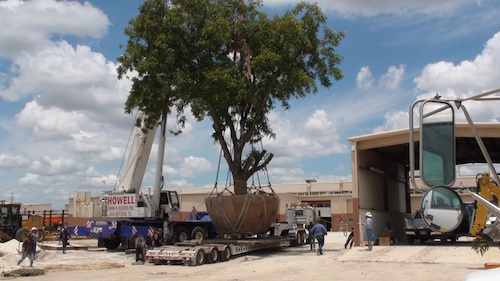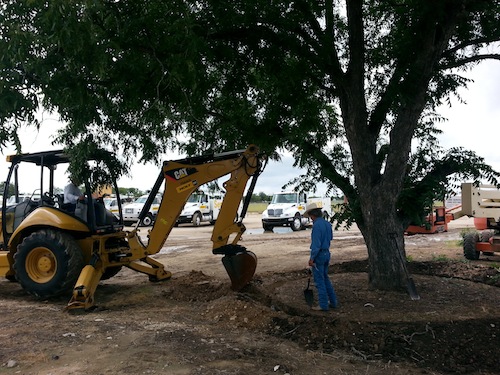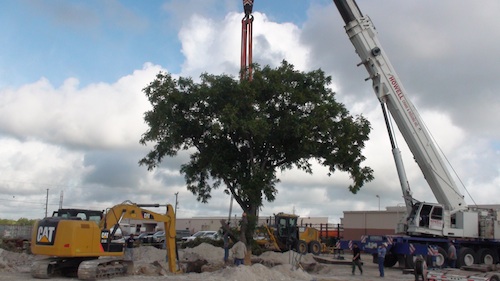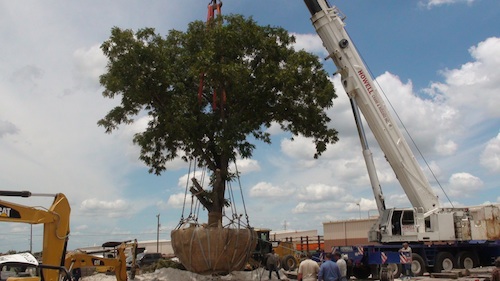Hey I got some photos from Armand so you can see the whole process. If you didn’t know, we have a guessing game of trying to figure out how big the tap root was on this huge pecan tree being moved. Read that article first, and then come back here to maximize your fun.
Click here to read the first article.
Here are some photos of the actual tree being moved. Scroll down to the bottom and I’ll tell you how big the taproot was!
This is how they started – kinda small ring if you ask me…
More and more digging.
Up she goes!
On a trailer and off to her new home.
Armand assures me that this tree will survive. They are watering her twice a day. And her new hole had, uh 6 or 7 semi-truck loads of good soil and compost in it. Actually they are wondering if the tree will go into shock at getting to this new source of fertility.
Now the question was – how big do you think the taproot was at the bottom of the root ball? The root ball was about 10 high as you can see.
There was NO taproot at 10′. Zip. Nada.
Here is why. The ground is solid caliche. Solid rock, There is nothing in the ground for the tree roots to go after. No water, no nutrition, nothing. So the tree sends out root just below the surface.
I spend time each year on a journey to the Sonoran desert for medicine and skills. Everywhere for miles is creosote bush after creosote bush. Chaparral is another name. “Queen of the Desert” yet another. The bushes are typically spaced apart by about 8′ to 12′ – in a surprising uniformity. I was surprised to learn from those who have dug them, the roots of the creosote are only a few inches below ground and no more. There is absolutely no reason to go any deeper. Their strategy is to have the roots spread out along the ground in all directions to grab any moisture if it falls.
This pecan tree was doing the same thing. I wonder how productive the tree was in that rock? Was there much more soil when the tree was a young and growing seedling?
Anyway, hey wasn’t that fun? I loved all the diverse answers. Stay tuned for more wacky contests.
Marjory Wildcraft is an Expedition Leader and Bioneer Blogger with The [Grow] Network, which is an online community that recognizes the wisdom of “homegrown food on every table.” Marjory has been featured as an expert on sustainable living by National Geographic, she is a speaker at Mother Earth News fairs, and is a returning guest on Coast to Coast AM. She is an author of several books, but is best known for her “Grow Your Own Groceries” video series, which is used by more than 300,000 homesteaders, survivalists, universities, and missionary organizations around the world.











COMMENTS(0)
Marjory,
That was fun! I got a bit teary eyed seeing that final picture of the pecan tree raise. I bet it sends it’s hearty thanks. What a wonderful service to save old trees…I’ve never heard of that.
Thanks,
Eileen
Yes, Armand and his brother are quite concerned about these old trees. The only way to get a 150 year old tree is – have 150 years… such a treasure and we’ve wasted so many in earlier ages.
Beautiful put!!
You know Marjory that was so FaceBook sharable…maybe some share buttons would be a nice addition to your great site. I bet if you put a caption on the last picture…something like “How many people does it take to save an old pecan tree?” would really make it’s way around FaceBook, you could put your url on the image. Just a thought…I’ve been trying to figure out social media for myself lately.
Nice Pic’s Marjory,
Up here in in the N.E. it is common to see some tree roots come to the surface to fine water. As hiking trails ware down (mostly from ATV’s) they become a problem for some people who walk or peddle.
I keep hearing how Tx is such a great place but the heat, I don’t know about that heat. We may get a weeks worth and its a killer.
I wonce heard of placing camo over the plants to shade them a bit. Much like you would use a open net camo to hide some-thing from the above view. I don’t know if that would stop the burning of plants or keeping the tomatoes red instead of white. I never seen you try that.
Something kept nagging at me after I ‘guessed the size’, but as I had only just woken up I didn’t dwell on it too long.. Growing on rock… that was it! 🙂 Those of us that think we have some intelligence LOVE guessing games 🙂 Thank you!
Love Peace and Respect
Here in the N.E. the white Pine and Chestnut were near wiped out for the wood. We can plant a seed and grow it. Then plant it out doors. In the 1930’s the Goverment gave us free trees to plant. But that was back when we had a Goverment.
That’s amazing adaptation!
Here on the mountain in Tennessee the root ball does not have a tap root either. I cut a 60 foot Hickery
tree and dug up the root ball,it was only 30 inches deep. Forestry Service said the roots grow out 80 feet.
That WAS fun! I would have loved seeing that tree being hauled down the road too. Has to bring a smile and tug on your heart to see this tree being saved.
Thank you for sharing.
Margo;)
Hmm shows what kinda response curiosity will bring – give the answer & poof! Ha – one amazing tree & I guess that is a good point about abundance or adversity which brings out the best in trees or us. And not even a 10 foot tap root – you ought to reward the couple of folks who said that! I thought a tree needed as much below as it had above, but if you can’t push in one direction, go in the direction you can. Smart old tree – good lessons. Thx,
A related point that you may want to consider is that ALL plants
get the majority of their nutrition from the top foot of soil, so that’s
where most roots are located. Why? Because there is insufficient
oxygen below that to support biological action – the source of most nutrients
in useable form.
Hi Mitch! Good to hear from you.
That is a good point. Thanks for bringing that up. Yes, is a good topic for another post.
I pray that their effort to relocate is successful – but “just because we CAN doesn’t mean we should”.
Consider ALL the EMBEDDED energies that have been wasted on this very dubious effort. I personally would go to any length to save a tree — as long as it didn’t sacrifice other natural resources to do it. How many thousands of units of petroleum, oil, natural gas, coal and/or nuclear waste were spent to accomplish this endeavor? What was the carbon foot print? How many new saplings could have been planted and nurtured for the same expense of non-renewable polluting energies? And would future generations benefit more from the saving of this one pecan tree – or the planting of a thousand new pecan trees?
I’m not sure that the depth of the tape root is the story here.
Jeff, I completely agree with you abut the huge amount of wated energy on a project like this.
It is such a shame we’ve cut down all those big trees in the first place. Now we are down to such a few. And just why couldn’t they have put the building somewhere else?
But don’t get in the way of rich Texans….
The whole project reminded me of a nature show I saw one time where they were ‘saving’ big rare cats by using helicopters and a small army to relocate them to other areas.
Hello,
Can’t help but perk up at your mention of the creosote bush and its fibrous root system. Since you go there to study the medicine, you know, too, that the plant produces a toxin that keeps smaller babies from growing within its root system. Do you have Katherine Siva-Saubel’s books on the medical uses of the desert plants?
i used to give tours in the Coachella Valley, the flora and fauna was my favorite. i have lots of books and notes on the medicinal uses of the plants.
anyway, didn’t mean to divert from the original topic.
blessings,
Lori
Hi Lori, thanks for that reference on the desert plants and the Cahuilla people. I put it on my iwsh list on Amazon – they don’t have in stock right now.